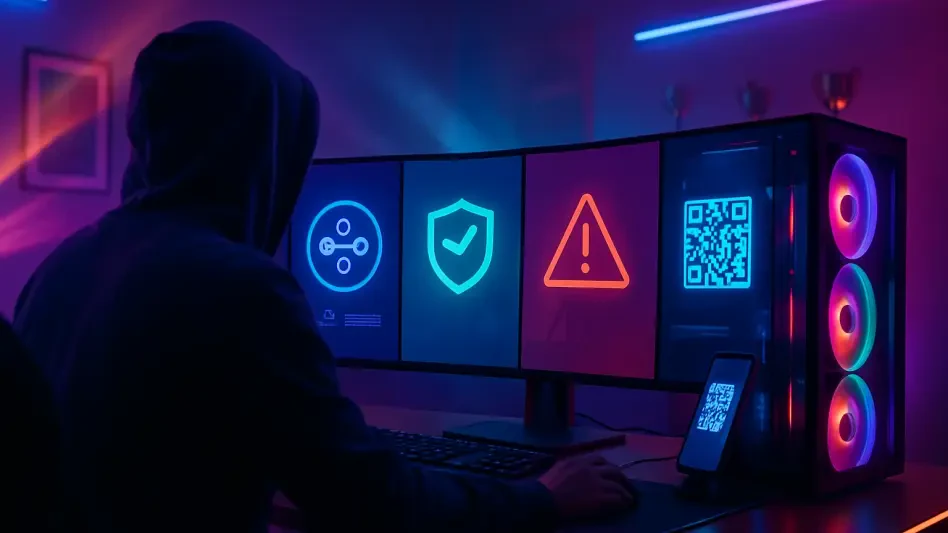Imagine a corporate network breached not by traditional malware, but by a deepfake audio impersonating a CEO, tricking employees into transferring millions. Such sophisticated threats are no longer the stuff of science fiction; they are a stark reality in today’s cybersecurity landscape, where over 4,000 companies operate globally in this sector. The industry is at a critical juncture, grappling with rapid technological advancements and increasingly complex cyber risks. Chief Information Security Officers (CISOs) face mounting pressure to safeguard organizations against these evolving dangers, often finding that established vendors alone cannot keep pace. This report delves into why partnering with cybersecurity startups offers a strategic advantage, exploring the current state of the industry, key market dynamics, and actionable insights for building resilient defenses.
The Current State of the Cybersecurity Landscape
The cybersecurity industry is undergoing a transformative phase, driven by an unrelenting surge in sophisticated threats and groundbreaking technologies. Innovations like artificial intelligence (AI), generative AI, and quantum computing have not only empowered organizations but also armed threat actors with tools to craft intricate attacks, from deepfake scams to AI-driven phishing campaigns. This rapid evolution demands equally dynamic responses, pushing the boundaries of traditional security measures and necessitating fresh approaches to defense.
Globally, the sector comprises over 4,000 companies, ranging from tech giants like Microsoft and Google to a burgeoning ecosystem of startups. While major players dominate with comprehensive platforms, startups are carving out significant influence by addressing niche vulnerabilities and pioneering cutting-edge solutions. Their role is becoming indispensable as organizations seek to diversify their security portfolios beyond the offerings of larger vendors, avoiding potential single points of failure.
The importance of cybersecurity has never been more pronounced, as businesses across industries face heightened risks that can cripple operations or erode customer trust. Protecting against these threats requires a proactive stance, leveraging both the stability of established solutions and the agility of emerging players. This dual approach is essential to counter the sophisticated tactics fueled by technological advancements, ensuring organizations remain resilient in an increasingly hostile digital environment.
Key Trends and Market Dynamics
Emerging Threats and the Push for Innovation
The cybersecurity arena is shaped by an alarming rise in complex threats that exploit cutting-edge technologies, challenging organizations to rethink their defensive strategies. Attack vectors such as AI-generated deepfakes and automated malware campaigns are outpacing conventional security tools, creating an urgent need for innovative countermeasures. This dynamic environment underscores the critical role of adaptability in staying ahead of adversaries who continuously refine their methods.
Startups are uniquely positioned to meet these challenges, often focusing on specialized areas like hardware-level security and secure-by-design principles. By embedding protection into the core architecture of technology, these smaller firms address future risks that larger vendors might overlook in favor of broader, less tailored solutions. Their nimbleness allows for rapid development and deployment of tools tailored to specific, emerging threats.
Organizations, in turn, must cultivate agility to respond to these market drivers and seize new opportunities. The ability to pivot quickly, integrating novel solutions from startups, enables businesses to fortify their defenses against unpredictable risks. This trend toward flexibility is not just a reaction to current threats but a strategic imperative to prepare for the unknown challenges lurking on the horizon.
Market Challenges and Growth Projections
Despite their potential, cybersecurity startups face significant economic hurdles that threaten their viability in a competitive landscape. Declining investment, compounded by high interest rates, restricts access to capital, while limited exit options like initial public offerings hinder growth prospects. These financial constraints create a challenging environment for smaller players striving to scale and innovate.
Market data also reveals a trend toward consolidation, with larger vendors pushing platformization to offer all-encompassing security suites. This shift often overshadows startups, as CISOs may hesitate to trust lesser-known entities lacking the brand recognition or proven track record of bigger firms. Building customer confidence remains a steep uphill battle for many emerging companies in this climate of skepticism.
Looking ahead, however, opportunities persist for startups that target specific security gaps with precision. Projections suggest that from 2025 to 2027, firms focusing on underserved areas like AI security or niche compliance needs can thrive, even amidst economic headwinds. By addressing these critical voids, startups can carve out sustainable niches, provided they effectively communicate their unique value to potential partners.
Challenges in Partnering with Cybersecurity Startups
Partnering with startups presents notable obstacles, largely due to the broader economic instability impacting their operations. High interest rates and reduced funding opportunities make it difficult for these firms to sustain growth or expand their reach, often leaving them resource-strapped. Additionally, many struggle to clearly articulate their value proposition, which can deter CISOs accustomed to the polished pitches of established vendors.
The competitive pressure from larger players further complicates the landscape, as platformization tempts security leaders to consolidate their tools with a single, familiar provider. This inclination toward comprehensive solutions from big vendors risks sidelining startups, whose innovative offerings might be dismissed as untested or incompatible. Such dynamics create a barrier to entry that smaller firms must navigate with limited marketing and outreach capabilities.
To overcome these challenges, both startups and CISOs can adopt strategic approaches like pilot programs to test solutions on a smaller scale before full implementation. Early adoption initiatives also provide a low-risk avenue for organizations to evaluate a startup’s potential impact. By fostering these collaborative testing grounds, both parties can build trust and align innovative tools with specific security needs, paving the way for successful partnerships.
Navigating Compliance and Security Needs
The regulatory environment in cybersecurity is a complex web of data protection laws and industry standards that startups must adeptly navigate to gain credibility. Compliance with frameworks such as GDPR or sector-specific mandates is non-negotiable for organizations, making it imperative that startup solutions align with these requirements. Failure to meet such standards can quickly erode trust and disqualify emerging firms from consideration.
For CISOs, partnering with startups that prioritize compliance offers a pathway to bolster trust and ensure seamless integration with existing security policies. Startups that demonstrate a deep understanding of regulatory demands can position themselves as reliable allies, easing concerns about potential legal or operational risks. This alignment is crucial for organizations aiming to maintain robust governance while exploring innovative tools.
Moreover, startups can enhance established security frameworks by delivering targeted, compliant solutions that address specific vulnerabilities without disrupting broader systems. Their ability to offer modular tools ensures that organizations can plug gaps in their defenses while adhering to strict standards. This complementary approach allows CISOs to balance innovation with the stringent demands of regulatory oversight, creating a cohesive security posture.
The Future of Cybersecurity with Startups
Looking toward the horizon, startups are poised to play a pivotal role in shaping the cybersecurity industry, particularly in areas like AI security and data protection. Their capacity for rapid innovation enables them to tackle emerging challenges that larger vendors may be slower to address due to bureaucratic constraints. This agility positions startups as frontrunners in developing defenses against next-generation threats.
Emerging technologies and market disruptors further highlight the unique advantages of smaller firms, which can pivot quickly to explore uncharted territories. Whether it’s countering quantum computing risks or securing generative AI applications, startups are often at the forefront of experimentation, offering solutions that anticipate rather than react to disruptions. Their forward-thinking mindset provides a critical edge in a field defined by constant change.
A hybrid strategy, blending the stability of established vendors with the dynamism of startups, emerges as the optimal path forward. Influenced by global economic conditions and innovation trends, this balanced approach ensures organizations can leverage comprehensive platforms while integrating specialized tools. Such a model fosters resilience, enabling CISOs to construct security architectures that are both robust and adaptable to future uncertainties.
Reflecting on Strategic Pathways Forward
Reflecting on the insights gathered, it becomes evident that the cybersecurity landscape demands a nuanced approach to partnerships, balancing innovation with stability. The exploration of market dynamics reveals how startups, despite economic challenges, offer indispensable solutions to counter sophisticated threats. Discussions around compliance and future trends underscore their potential to address niche risks that larger vendors often sideline.
Moving forward, CISOs are encouraged to take deliberate steps to forge meaningful collaborations with startups, such as participating in industry-specific incubators or innovation hubs to discover promising technologies. Establishing internal frameworks for rapid testing and feedback loops proves vital in integrating startup solutions effectively. These actions not only mitigate risks but also position organizations to capitalize on cutting-edge advancements.
Ultimately, the journey highlights that building resilient security architectures hinges on viewing startups as strategic allies rather than mere vendors. By investing in these relationships and championing a culture of experimentation, security leaders can anticipate emerging threats more adeptly. This proactive stance promises to strengthen defenses, ensuring organizations remain agile and prepared for the evolving digital battlefield.








